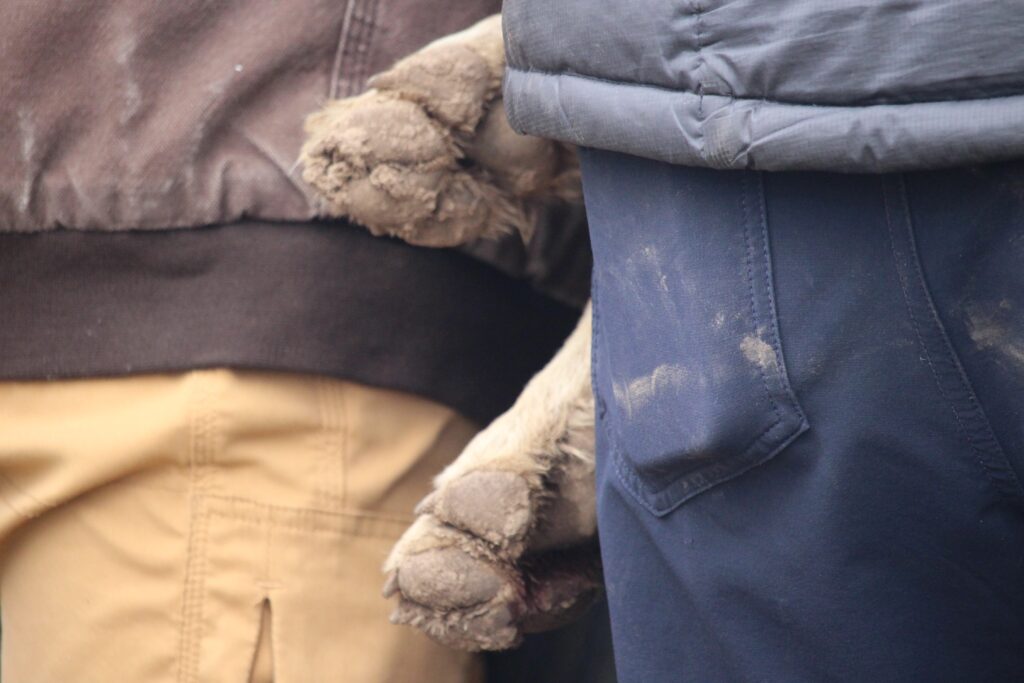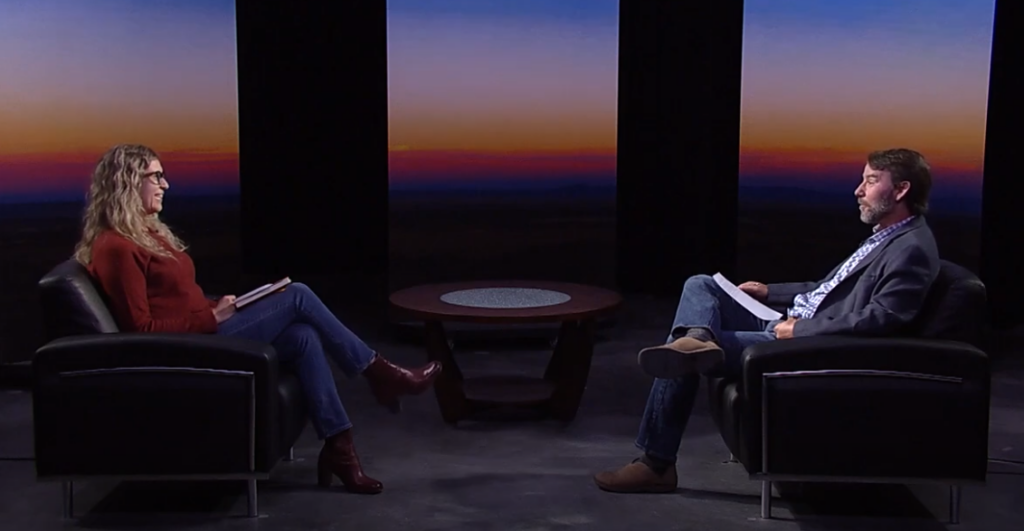‘We are marching steadily toward an uninsurable future…’

Last week, videographer John Britt and I headed out to Apache Creek so we could join the U.S. Fish and Wildlife Service and its partners for the annual Mexican wolf count. We’ll have that segment coming up for you next month.
For now, check out Instagram or YouTube to hear Brady McGee, Mexican Wolf Recovery Coordinator with the U.S. Fish and Wildlife Service, talk about F2754 (also called Asha by many people), the intrepid female wolf who has twice dispersed from her pack and traveled north of Interstate 40.
Also on social media, you can watch Rebekah Keating, an intern with the Mexican Wolf Recovery Program, carrying a young female wolf from the Leon Pack in New Mexico.
On New Mexico in Focus last week, I spoke with Executive Producer Jeff Proctor about my plans for the show in 2024. You can watch that conversation online.
The gist? I’m talking a lot about climate change this year.
And if you’re here reading the newsletter, that’s the best place to find the latest news and analysis. That’s because of course, it’s always great when national outlets like The New Yorker (I mean, obviously I love Elizabeth Kolbert’s reporting) cover climate change in big, sweeping ways. But the stories I appreciate the most are from local reporters covering their own communities.
Here are a few recent stories, in case you want some localized climate news from various places:
• “’I can tell you it’s warming.’ WHOI scientist on new state climate panel says time is now” (Heather McCarron, Cape Cod Times)
• “Alaska’s Arctic and boreal ecosystems see climate change-driven ‘microbial awakening’” (Kavitha George, Alaska Public Media)
• “El Niño and climate change are supercharging incoming storm, SoCal’s biggest this winter” (Hayley Smith and Grace Toohey, Los Angeles Times)
• “Scientists say worse to come as Himalayan snow ceases” (Nidhi Jamwal, The Third Pole)

And in the Santa Fe New Mexican over the weekend, Maya Hilty reported how insurance companies are dropping some homeowners in Santa Fe because of climate-related risks like wildfire. This is already a huge issue in places like California and Florida—and it’s not going to get any better or easier in the coming years. Profit-driven insurance companies are adapting to the new world, but most people, communities, and municipalities are not. (For example, municipalities want the taxes homeowners pay when developers pop houses into areas prone to wildfire, flooding, or mudslides.)
Hilty reports that the New Mexico Office of Superintendent of Insurance enacted an “emergency rule requiring insurance companies to give 30 days’ notice if they plan to pull out of the state.” And the New Mexico Legislature can follow the lead of places like Florida and California to subsidize state-mandated property insurance plans. (Or, as a society, we can accept that only the wealthiest people—who can afford really expensive, high-risk insurance—live in places like the wildland urban interface or along coastlines.) None of these options touch the real problem.
Instead, we need to consider the words of Dave Jones, Director of the Climate Risk Initiative at the Center for Law Energy & the Environment at the University of California Berkeley, who I saw speak late last year: “We are marching steadily toward an uninsurable future because we are not acting aggressively and fast enough to reduce greenhouse gas emissions.”
If you missed the big news from New Jersey, check out the NJ Spotlight News story about Holtec. As Jeff Pillets reports:
“Holtec International, the Camden firm behind controversial nuclear power projects in New Jersey and four other states, has agreed to pay a $5 million penalty to avoid criminal prosecution connected to a state tax break scheme.
New Jersey Attorney General Matthew J. Platkin announced Tuesday that Holtec has been stripped of $1 million awarded by the state in 2018 under the Angel Investor Tax Break Program. Holtec will also submit to independent monitoring by the state for three years regarding any application for further state benefits, Platkin said.
The agreement, which also covers a real estate company owned by Holtec founder and CEO Krishna Singh, came after a lengthy criminal investigation that discovered Holtec had submitted false information to the state in seeking the Angel tax breaks.”
And more environmental news:
• “Oil and Gas Regulatory Bills Still Alive in New Mexico Legislature” (Jerry Redfern, Capital & Main)
• “Governor unveils 50-year water action plan” (Danielle Prokop, Source New Mexico)
• “Agriculture built these High Plains towns. Now, it might run them dry.” (Kevin Hardy and Allison Kite, Stateline)
• “EPA proposes new rules after Lujan Grisham’s PFAS petition” (Hannah Grover, New Mexico Political Report)
• “State recruits firefighters for what could become New Mexico’s first-ever Hotshots” (Gabrielle Porter, Santa Fe New Mexican)
The Department of Energy is hosting a second public meeting on the Los Alamos National Laboratory Electrical Power Capacity Upgrade Project Draft Environmental Assessment. That meeting is scheduled for Thursday, Feb. 15, 2024, from 4 to 7 p.m., at the Santa Fe Community College, Jemez Room, 6401 Richards Avenue, Santa Fe, N.M. 87508.
If you want to join virtually, the hybrid meeting begins at 4:30, and here’s the information:
http://tinyurl.com/LANLEPCUEA2
Meeting ID: 216 364 231 301
Passcode: KWf2M2
To join the meeting by telephone, call: 719-283-1404
Phone Conference ID: 660 740 035#
The public comment period will close February 20. To read the document, visit the NNSA’s project page. (You can also read about the project on the LANL website.) To submit comments email EPCUEA@nnsa.doe.gov or drop a paper copy to: NNSA Los Alamos Field Office, ATTN: EPCU Project NEPA, 3747 West Jemez Road, Los Alamos, NM 87544.
And, another goodbye. This time to Stanley Crawford, writer, garlic farmer, member of the New Mexico Legal Aid Board, and trustee on the Jemez Mountains Electric Cooperative. You can read Julia Goldberg’s piece at the Santa Fe Reporter, which includes some lovely photos, too. And yep, I teared up reading his words, “Friendship(s) are everything.”
P.S. If a friend forwarded you this message, sign up here to receive the newsletter yourself. You can also read recent newsletters online. And if you miss us throughout the week, follow Our Land on Instagram.


